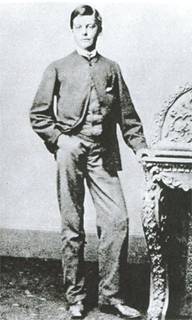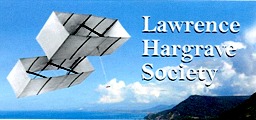 Lawrence Hargrave was born in England on 29 January 1850. He was the second of four children to John Fletcher Hargrave (1815-1885) who had married his first cousin, Ann Hargrave. John Fletcher, an English barrister, came to Sydney, New South Wales, Australia in 1857, without his wife and with his eldest son Ralph, and was appointed a NSW district court judge but resigned this position to enter parliament. He was variously solicitor-general and attorney-general from 1859-65, when he was appointed a puisne judge of the Supreme Court. He shortly afterwards became primary judge in equity, and in 1873 first judge of the divorce court. He retired in 1881 and died at Sydney in February 1885.
Lawrence Hargrave was born in England on 29 January 1850. He was the second of four children to John Fletcher Hargrave (1815-1885) who had married his first cousin, Ann Hargrave. John Fletcher, an English barrister, came to Sydney, New South Wales, Australia in 1857, without his wife and with his eldest son Ralph, and was appointed a NSW district court judge but resigned this position to enter parliament. He was variously solicitor-general and attorney-general from 1859-65, when he was appointed a puisne judge of the Supreme Court. He shortly afterwards became primary judge in equity, and in 1873 first judge of the divorce court. He retired in 1881 and died at Sydney in February 1885.
Lawrence arrived in Sydney in 1866, ostensibly to complete his studies and matriculate to the University of Sydney, his father desirous of the obviously talented Lawrence to follow his footsteps into Law. Lawrence however had been invited to circumnavigate Australia on his voyage out, and failed to matriculate, the explorer too strong for the academic. He was allowed to join the circumnavigation voyage while only 16, catching the exploration bug.
 He gained an apprenticeship in the Australian Steam Navigation Company, the experience of great use later in designing and constructing his models. His skills were shown early on in such things as a 25 foot outrigger, the ‘Shark’, built in 1869. A year later he could caused something of a sensation on Rushcutters Bay by ‘walking on the water’ in boat-shaped shoes with a system of flaps on the bottom to provide traction in the water.
He gained an apprenticeship in the Australian Steam Navigation Company, the experience of great use later in designing and constructing his models. His skills were shown early on in such things as a 25 foot outrigger, the ‘Shark’, built in 1869. A year later he could caused something of a sensation on Rushcutters Bay by ‘walking on the water’ in boat-shaped shoes with a system of flaps on the bottom to provide traction in the water.
In 1872 he went on a voyage to New Guinea but was ship-wrecked, lucky to escape with his life, many others dying. In 1875 he successfully sailed as an engineer on an expedition to the Gulf of Papua. From October 1875 to January 1876 he was exploring the hinterland of Port Moresby, and in April 1876 went on another expedition under Luigi D'Albertis for over 400 miles up the Fly River. He was in high demand as an explorer, for his level-headed, resourceful, and inventive nature.
Instead he returned to Sydney and married Margaret Preston Johnson in 1878, settling down from physical exploration, turning his attention to exploration of a different kind. Their family grew to 6 children, one of whom died in infancy.
As a famous explorer, Hargrave joined the Royal Society of New South Wales in 1877, and in 1878 became an assistant astronomical observer at Sydney observatory until 1883. He built four adding machines to assist his astronomical work.
Propulsion, how objects can be moved through the air, was one of Hargrave’s concerns. He examined propulsion in many forms, on land, water and air. He was able to use wave power in the sea to propel boats forward against the waves, something he enjoyed demonstrating to his family. He developed what he called the Trochoided plane theory in 1882, explaining how fish swim, and snakes slide, in a side to side motion, and how this might be used in the wing movement of flying machines.
He was interested in the study of aviation and looked for inspiration from the flight of birds. His work was featured by painstaking experimentation resulting in numerous models, and his results presented before the Royal Society of New South Wales in many papers. He refused on principle to patent any of his ideas or inventions, disseminating them freely to the aeronautical world.
During the early 1880s his father, John Fletcher, distributed to sons Ralph and Lawrence land he owned in Northern Illawarra, Stanwell Park and the Coalcliff, which was sought by rival coal mining companies, paying handsomely to Lawrence. This enabled him to resign from the Observatory in 1884, build three terrace houses in Rushcutters Bay, and from the workshop below one if these houses and turned his attention almost full time to aeronautical research.
References:
Adams, Michael. Wind Beneath his Wings: Lawrence Hargrave at Stanwell Park, Cultural Exchange International Pty. Ltd., 2005.
Bradshaw, Gary, et. al. ‘To fly is everything: a virtual museum covering the invention of the airplane,’ http://invention.psychology.msstate.edu/
Chanute, Octave , Progress in Flying Machines, Dover, 1894, reprinted 1998.
Craddock, David A. Ravensbourne to Airborne. Aspects of Lawrence Hargrave’s contribution to the science of aeronautics, Epping, 1994.
Debenham, Ian. ‘Lawrence Hargrave: His Role in the Development of the Successful Aeroplane’, 1998. www.ctie.monash.edu/hargrave/debenham.html. Updated on this website, 2009.
Grainger, E. Hargrave and Son. St Lucia: University of Queensland Press, 1978.
Hargrave papers (Museum of Applied Arts and Sciences, Sydney, and National Library of Australia).
Hudson Shaw, W. and Ruhen, O. Lawrence Hargrave: Explorer, Inventor and Aviation Experimenter, Sydney : Cassell Australia, 1977.
Inglis, Amirah. 'Hargrave, Lawrence (1850 - 1915)', Australian Dictionary of Biography, Volume 9, MUP, 1983, pp 196–198.
Inglis, ‘Trials of an inventor in New South Wales: the case of Lawrence Hargrave’, Records of the Australian Academy of Science, 1, Dec, 1966, no 1.
Lindsay, Norman, Bohemians of the Bulletin, Sydney, 1965.
McFarland, MW, The Papers of Orville and Wilbur Wright, McGraw Hill, 1953, re-published in 2001.
Naughton, Dr. Russell and Prof. John Bird. ‘Hargrave Aviation and Aeromodelling—
Interdependent Evolutions and Histories,’ www.ctie.monash.edu/hargrave/gallery1.
Pelham, D., The Penguin Book of Kites, Harmondsworth: Penguin Books Ltd., 1976.
Roughley, T.C., The Technical Gazette of N.S.W., 1923-4, reprinted as a pamphlet; The Aeronautical Work of Lawrence Hargrave, bulletin No. 19, Technological Museum, Sydney.
Royal Society of New South Wales, A Century of Scientific Progress, Sydney, 1968.
Journal and Proceedings of the Royal Society of New South Wales, various volumes, 1884 to 1909.
Salier, C. W., Journal and Proceedings Royal Australian Historical Society, vol. XV; The Australian Quarterly, March 1940, reprinted as a pamphlet.
Shaw, W. H. & Ruben, O. Lawrence Hargrave: Explorer, Inventor and Aviation Experimenter. Stanmore: Cassell Australia, 1977.
Walker, J. D. (1984). Lawrence Hargrave: Australia’s Pioneer Aeronautical Scientist. Canberra: Australian Government Printing Service.
External links
- Winged Figure Lawrence Hargrave Memorial
- The Hargrave Files papers and drawings by Lawrence Hargrave, and miscellaneous articles about Hargrave's kites from the archives of the Australian Kite Association
- www.ctie.monash.edu.au/hargrave, Website hosted by the Centre for Telecommunications and Information Engineering, Monash University, Australia.

